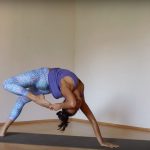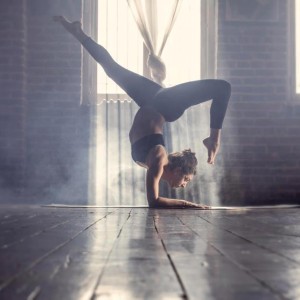What’s The Deal With Savasana? ~Maya Devi Georg
In the almost 20 years I have been teaching yoga, my sister has attended only one of my classes. Her big take-away was that yoga was “a workout with a nap at the end.” What else does lying flat on your back with eyes closed look like?
To new or unaware practitioners, savasana does appear to be little more than a mini-nap. To the high strung (like I was when I began my practice decades ago) it is usually the most frustrating part of the class.
When I began my practice it was with VHF tapes, and I would just switch off the VCR and avoid the weird hippy trip at the end of the practice. When I finally began to take classes I would lay on the floor, eyes wide open and staring at the ceiling waiting for the required stillness to end so that I could get on with my day.
It took a while before I allowed myself to relax, and years later I learned what savasana was really all about.
Deep Relaxation
Most people relax only at the end of their day, as they lay in bed and go to sleep (which is why so many beginners fall asleep in savasana). But learning to relax – and stay conscious – is probably the most challenging lesson to learn for most practitioners.
In order to relax the body one must first become aware of the tensions held in our bodies. This seems obvious, but the tension we carry in our muscles develops slowly, usually through years of bad posture and mental stress. Our tensions sneak up on us, and we are no more aware of them than a lobster in a pot is aware of the water slowly boiling around it.
Simultaneously, we limit our awareness to our work, family, and responsibilities. We only become aware of our bodies when we experience illness or pain.
Asana is not enough to reconcile our awareness back to our bodies – Savasana is meant to bring awareness back to the physical body.
Yes, yoga means ‘union’, and that unification is not just between our souls and the divine, but between our minds and bodies.
Savasana vs. Yoga Nidra
Many people, practitioners and yoga teachers alike, conflate savasana and yoga nidra. Savasana (meaning ‘corpse pose’) is an asana where the practitioner is laying supine and the entire body is completely relaxed. The arms and legs are spread wide so that no part of the body is touching any other part of the body. And the palms are facing upward to signal to the nervous system that body is resting. That is the entirety of the practice.
We practice savasana when we have finished our asana practice to remove any tension we may have created in our bodies, as well as to ground any excess energy so that we can next perform our pranayama and then meditation.
Yoga nidra (meaning ‘yogic sleep’) is a practice that requires the practitioner to be in savasana, as they follow a meditation, usually consisting of mental visualizations as well as imagining different physical sensations (like heaviness and/or lightness).
I know, the two look identical. However, the biggest difference between the two is that yoga nidra is a practice to cement a sankalpa – a resolve, vow, or intention.
At the beginning of a yoga nidra practice, the participant mentally repeats their sankalpa, and they then perform their meditation, again repeating their sankalpa as their meditation ends. This is almost like a form of self hypnosis, and while some teachers do lead their students through a guided relaxation that may include visualizations as well as imagining different physical sensations, if there is no sankalpa it is still only savasana.
How To Savasana
I firmly believe that everyone needs to learn how to relax. If relaxation was instinctive we would all be living healthier and happier lives. But we can all learn how to join our mental and physical awareness – if I could do it, anyone can!
The easiest way is to simply lay in savasana and conduct a mental inventory of the body, beginning with the toes and working your way up, ending with the crown of the head. Bring your awareness to each part of your body and try to feel it, look for any tension there and imagine the in-breath moving into that part of the body, so that the exhalation will carry the tension out of the body.
There are many guided relaxation recordings and books, or you can ask your yoga teacher to include a guided relaxation at the end of your next class, although a good yoga teacher will always prepare students for savasana. (Nothing is more disrespectful to students than to put them in savasana, turn off the lights, and abandon them without any guidance as to how to relax, or to help them back out of that relaxed state.)
Savasana might look like a nap, and to beginners it might feel like a nap. But it is a vital part of the practice joining consciousness and matter, body and mind, action and relaxation. It is a practice to resolve and unify opposites, and it is the most obvious and attainable practice for those seeking to experience Yoga as union.




